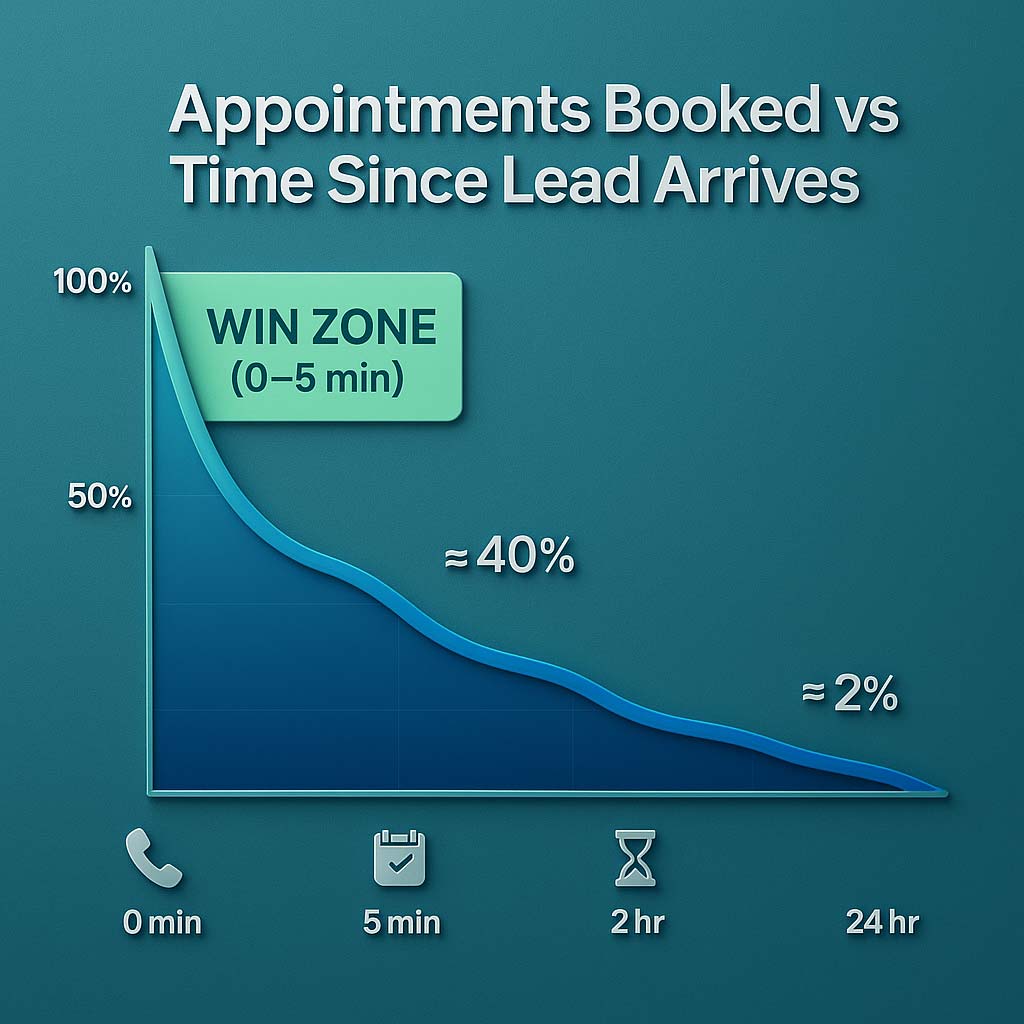Does replying to patients within seconds meaningfully increase booked appointments and retention for a dental practice?
Direct answer:
Yes. When you respond immediately (human‑like, via AI or human), you catch intent at its peak. Decades of lead‑response research show the first few minutes dominate outcomes. Yet, amazingly, most organizations still respond in hours. In dental, a large share of bookings happens after hours, so instant engagement is often the only way to win the moment. Faster replies drive more booked appointments, higher revenue per lead, and better retention for existing patients.
TL;DR
- 5 minutes matter. Odds of contacting a lead in 5 minutes vs. 30 minutes drop about 90%; your chance of scheduling them drops just as much. Minutes decide revenue.
- Competitors are still slow. A landmark audit found average response times measured in hours (≈42 hours); many never replied. Being first remains a durable edge.
- Patients book when you’re closed. Zocdoc’s 2024 patient data: nearly half of all appointments were booked after hours (5 p.m.–9 a.m.). If you don’t engage, then someone else will.
- Consumers expect “now.” Roughly 72% of customers want immediate service; quick resolution correlates with loyalty.
- Calls can’t sit on hold. One industry analysis pegs average healthcare hold time at 4.4 minutes, but leakage starts within 30 seconds. (No, voicemail ≠ service.)
- Faster message response ↔ satisfaction. New JAMA Network Open work links message responsiveness to higher patient satisfaction. Faster replies aren’t just polite; they’re measurable experience drivers.
CRTX internal data: Across 1+ million patient contacts, shrinking time‑to‑first‑contact reliably lifted booked‑per‑100‑leads. (CRTX dataset, 2024–2025.)
Why “time to contact” works
- You meet intent at peak. Motivation decays quickly; minutes decide revenue.
- You win the tie. When choices look similar online, the first real conversation wins disproportionally.
- You match modern habits. Patients reach out after office hours (at 5:05 p.m. and 10:30 p.m.), not just 9–5. Instant replies capture that demand and steal market share.
How to implement
Define the metric.
- Time to Contact (TTC): seconds/minutes from the patient’s first touch (call/text/chat/form/email/DM) to the first human‑like reply (AI or human) that allows questions and action. Auto‑emails don’t count.
Set clear targets.
- Phone/SMS/Chat/DM: <60 seconds first reply.
- Forms/Email: trigger instant text or callback; same <60 seconds goal.
- Publish your promise: “We reply in minutes, 7 days a week” and keep it.
Cover every channel.
- Phone: answer; keep holds <60s; replace voicemail with live answer or instant text-back.
- SMS/Chat/DM: greet in seconds with replies that are in context, meaning they're not generic or canned and appear like a human is responding.
- Forms/Email: fire an immediate human‑like outreach (text/call), not just an auto‑receipt.
Keep it safe and humane.
- Minimum‑necessary info pre‑booking; no clinical advice in qualification.
- Bring a person in for: pain ≥7/10, swelling/fever, “please call me,” distress, or complex finance/insurance.
Book quickly (without friction).
- If you can write into the PMS, do it. If not, take an appointment request or send an online scheduling link to lock intent.
14‑day experiment: Prove it in your data
- Goal: increase booked appointments per 100 leads without raising ad spend.
- Change: guarantee <60s first reply on all channels, including after hours.
- Track:
- Median & 90th‑percentile Time to Contact by channel.
- Booked per 100 leads and revenue per lead (fee × acceptance).
- Retention/churn on existing patients who message (correlate with first response time / first contact resolution).
- After‑hours share of bookings as a % of total.
- Guardrails: escalate urgent cues to a human; respect quiet‑hour policies; document hand‑offs.
What to expect: Realistic lift
- More booked appointments from the same traffic (the 5‑minute effect).
- Higher revenue per lead as fewer high‑intent inquiries drift away after hours.
- Better retention as faster replies to existing patients raise satisfaction and loyalty. (Responsiveness → higher patient satisfaction.)
DIY vs. comprehensive
You can DIY this: tighten routing, publish a minutes‑level guarantee, and staff (or AI) to answer instantly across phone/text/chat/forms/DMs. If you want the comprehensive, HIPAA‑compliant system that answers in seconds, books the appointment, and brings a person in when it matters, start with CRTX.
Hire Your CRTX Agents.
Until the next wave,
Bill Hanekamp
AI Evangelist & Developer of CRTX
CEO, Microsite Health
Sources (key references)
-
MIT / InsideSales, Lead Response Management Study (contact odds drop ~100×; qualify ~21× in 5 vs. 30 minutes). HubSpot
-
HBR, The Short Life of Online Sales Leads (average response ≈ 42 hours; many never respond). ResearchGate
-
Zocdoc, What Patients Want 2024 (nearly half of appointments booked after hours). Zocdoc
-
Zendesk, CX Trends (≈72% of customers want immediate service; quick resolution ↔ loyalty). Zendesk
-
Dialog Health / HFMA (healthcare call‑center hold times ≈ 4.4 min vs. ~50s target). Dialog Health
-
JAMA Network Open (2025): Message responsiveness associated with higher patient satisfaction (Press Ganey domains). JAMA Network
-
CRTX internal white paper: The 5‑Minute Golden Window (definition and healthcare context).
